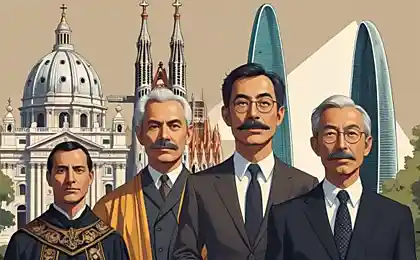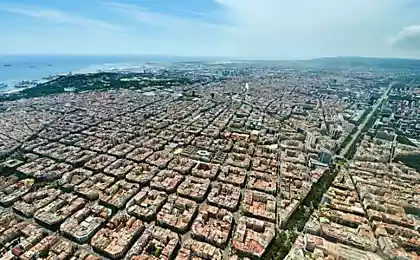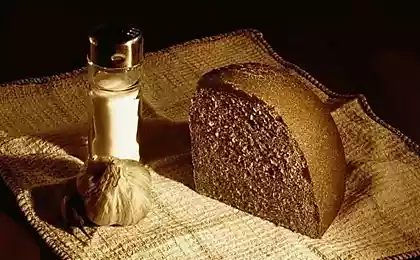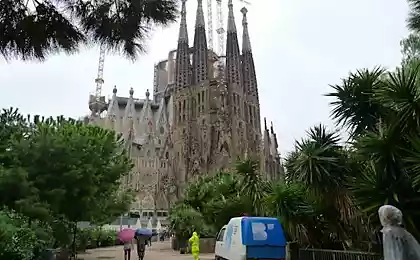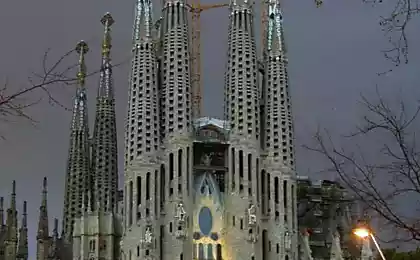464
Antonio Gaudi — great Creator and pitiful beggar
It's hard to find a brilliant person who is not passionate about their work. But not everyone is so fanatical, to oblivion goes to work, as the Spanish architect Antonio Gaudi I cornet (1852 – 1926), who was often referred to simply as Gaudi. Not to say that the name Gaudi "shrouded in mystery". Although during the civil war in Spain was destroyed biographical documents of the architect's drawings and layouts.
Antonio, the son of the town Tinker, suffered from childhood with rheumatism and was not able to play with other children. Gaudi himself later claimed that art is a gift that can be inherited, and that "his capacity for spatial representation inherited from three generations of coppersmiths, ancestors on the paternal side"1. In everyday life, closed, unsociable guy, no luck. At school he was considered average, although he admitted that he perfectly painted. Having received special education and order for construction in the city of Mataro, Gaudi there, he met his first love.

Antonio Gaudi
Unfortunately, and perhaps fortunately for posterity, his novel ended dramatically. Gaudí left his bride, not wishing to listen to any explanation, cost him only to find out about her chance meeting in the train with a former classmate. Later she married another, and gaudí remained a bachelor all his life and was furious at the sight of the kissing lovers. In 1877, when gaudí graduated from the Provincial school of architecture in Barcelona, the Director, with the award of the diploma, said: "Gentlemen, in front of us or a genius or a madman!" It is noteworthy that the concept of genius was applied to it so early.
Gaudi differed unbearable character and strong will. Having no other relatives, he literally terrorized his niece, not allowing her to meet with any young man. The disciples were admitted, argue that gaudí was absolutely impossible: it was threatened with exclusion from the workshop. Worked with it architects played the role of exclusively part-time workers: none of their proposals are not accepted and not even listened to. On his face as if it was written the word "despot." Interlocutors from the first glance was struck by the arrogant, supercilious expression with a stubborn chin grimly and shifted to the nose eyebrows. Wizards are respected and feared, as he was always harsh, eccentric and closed.
Early memories bring to us "the image of the perfectly dressed and ommunicating Gaudi-student". It is possible that such a "luxury image" helped the young architect to feel more confident in society. But soon from the former panache and secularism has not disappeared. His appearance and clothing began to obey the same principle — make it easy: shapeless suit and shoes made from the roots of zucchini. Becoming a deeply religious man, he kept all of the posts, and his food consisted mainly of raw vegetables, olive oil, nuts, honey, bread and spring water. Overly fanatical about treating religious practice, in 1894, during the Great lent Gaudi exposed himself to such severe asceticism that some time after this was forced to be on bed rest.
Gaudí, we can say, lived and worked on the construction site. He was not interested in anything except work, did not care about income, claiming: "People are divided into two types: men of words and men of action. First they say the second act. I'm from the second group." Since 1914, gaudí left the work on private orders, and devoted himself entirely to the construction of their latest masterpiece — the temple complex of the Holy family in Barcelona. Officially, the architect of this project, he was appointed in 1884.
He boldly assumed the user has already started the works and began to build an unprecedented structure with a 170-metre towers, fantastic shapes, spiral staircases, a mosaic of Venetian glass. Not thinking about anything else, the architect "believed in his Messianic mission. He lived as a hermit in his workshop at the construction site and comes out only from time to time, "hat in hand" to raise funds for the construction of the temple. During these years he lived only for his child".
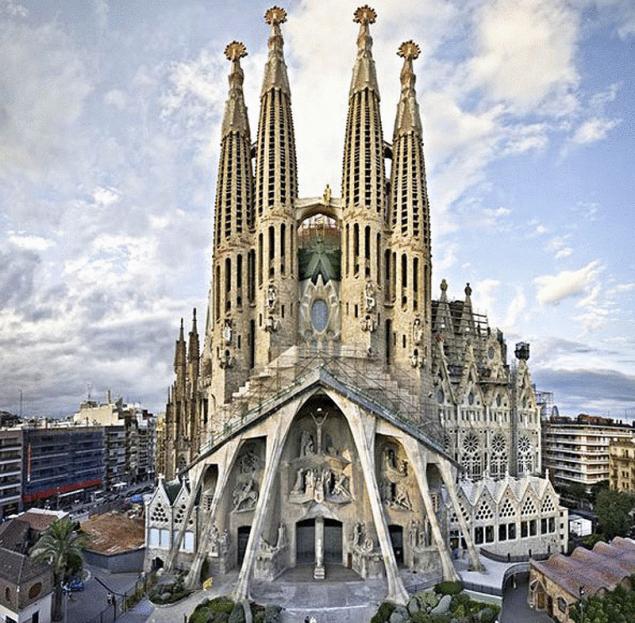
Sagrada Familia
Wanting to capture the authentic truth of life, he made casts of stillborn babies to portray the facade of the children slain by Herod's order. These plaster corpses, hanging in rows from the ceiling of his Studio, terrified the workers. Fellow architects have called exclusively distinctive style of Gaudi "Holy ugliness". Truly have to be a genius to decide to build a bizarre house with a snake-like wriggling façade and on the complaint of the tenants that the apartment at the crooked corridors you can't bring a piano to answer: "Play the violin".
An example of this construction it is possible to see just how painstaking and difficult was the work of gaudí as an architect-Builder. First he made a model of the house scale 1:10. Then I painted on the wavy surface of the facade all the curves and projections. After that, the model was sawn into pieces that are distributed across corresponding points of the construction site so that the masons could see the samples that they were carving. Drawings of individual parts were made in natural size and is also echoed in different areas of the house.
Tragic-absurd death of the old architect, hit by a tram just a few steps from your construction site, its natural. Constantly advanced in the development of new ideas, Gaudi paid little attention to his surroundings. 7 Jun 1926 in exactly 17 hours and 30 minutes gaudí left under construction, but already a famous Cathedral "Sagrada Familia" and, as always, went to evening confession.

According to legend, on this day in Barcelona was solemnly launched the first tram. The driver then justified that some drunk hobo on the fault was on his way. The papers he had, in his pockets found only the gospel and a handful of nuts, and the pants rested on English pins. Three days later from his injuries, Gaudi died in a homeless shelter.
He was buried in a common grave, but the architect and recognized a woman. By special permission of the Pope, Antoni gaudí was buried in the crypt of the Cathedral "Sagrada Familia".
Gaudi until the end of days maintain clarity of mind, but it should be noted the excessive absent-mindedness of genius. In the diagnostic plan, Gaudi suggest the presence of a schizoid personality disorder. published
P. S. And remember, only by changing their consumption — together we change the world! ©
Source: www.psyh.ru/rubric/7/articles/2306/
Antonio, the son of the town Tinker, suffered from childhood with rheumatism and was not able to play with other children. Gaudi himself later claimed that art is a gift that can be inherited, and that "his capacity for spatial representation inherited from three generations of coppersmiths, ancestors on the paternal side"1. In everyday life, closed, unsociable guy, no luck. At school he was considered average, although he admitted that he perfectly painted. Having received special education and order for construction in the city of Mataro, Gaudi there, he met his first love.

Antonio Gaudi
Unfortunately, and perhaps fortunately for posterity, his novel ended dramatically. Gaudí left his bride, not wishing to listen to any explanation, cost him only to find out about her chance meeting in the train with a former classmate. Later she married another, and gaudí remained a bachelor all his life and was furious at the sight of the kissing lovers. In 1877, when gaudí graduated from the Provincial school of architecture in Barcelona, the Director, with the award of the diploma, said: "Gentlemen, in front of us or a genius or a madman!" It is noteworthy that the concept of genius was applied to it so early.
Gaudi differed unbearable character and strong will. Having no other relatives, he literally terrorized his niece, not allowing her to meet with any young man. The disciples were admitted, argue that gaudí was absolutely impossible: it was threatened with exclusion from the workshop. Worked with it architects played the role of exclusively part-time workers: none of their proposals are not accepted and not even listened to. On his face as if it was written the word "despot." Interlocutors from the first glance was struck by the arrogant, supercilious expression with a stubborn chin grimly and shifted to the nose eyebrows. Wizards are respected and feared, as he was always harsh, eccentric and closed.
Early memories bring to us "the image of the perfectly dressed and ommunicating Gaudi-student". It is possible that such a "luxury image" helped the young architect to feel more confident in society. But soon from the former panache and secularism has not disappeared. His appearance and clothing began to obey the same principle — make it easy: shapeless suit and shoes made from the roots of zucchini. Becoming a deeply religious man, he kept all of the posts, and his food consisted mainly of raw vegetables, olive oil, nuts, honey, bread and spring water. Overly fanatical about treating religious practice, in 1894, during the Great lent Gaudi exposed himself to such severe asceticism that some time after this was forced to be on bed rest.
Gaudí, we can say, lived and worked on the construction site. He was not interested in anything except work, did not care about income, claiming: "People are divided into two types: men of words and men of action. First they say the second act. I'm from the second group." Since 1914, gaudí left the work on private orders, and devoted himself entirely to the construction of their latest masterpiece — the temple complex of the Holy family in Barcelona. Officially, the architect of this project, he was appointed in 1884.
He boldly assumed the user has already started the works and began to build an unprecedented structure with a 170-metre towers, fantastic shapes, spiral staircases, a mosaic of Venetian glass. Not thinking about anything else, the architect "believed in his Messianic mission. He lived as a hermit in his workshop at the construction site and comes out only from time to time, "hat in hand" to raise funds for the construction of the temple. During these years he lived only for his child".

Sagrada Familia
Wanting to capture the authentic truth of life, he made casts of stillborn babies to portray the facade of the children slain by Herod's order. These plaster corpses, hanging in rows from the ceiling of his Studio, terrified the workers. Fellow architects have called exclusively distinctive style of Gaudi "Holy ugliness". Truly have to be a genius to decide to build a bizarre house with a snake-like wriggling façade and on the complaint of the tenants that the apartment at the crooked corridors you can't bring a piano to answer: "Play the violin".
An example of this construction it is possible to see just how painstaking and difficult was the work of gaudí as an architect-Builder. First he made a model of the house scale 1:10. Then I painted on the wavy surface of the facade all the curves and projections. After that, the model was sawn into pieces that are distributed across corresponding points of the construction site so that the masons could see the samples that they were carving. Drawings of individual parts were made in natural size and is also echoed in different areas of the house.
Tragic-absurd death of the old architect, hit by a tram just a few steps from your construction site, its natural. Constantly advanced in the development of new ideas, Gaudi paid little attention to his surroundings. 7 Jun 1926 in exactly 17 hours and 30 minutes gaudí left under construction, but already a famous Cathedral "Sagrada Familia" and, as always, went to evening confession.

According to legend, on this day in Barcelona was solemnly launched the first tram. The driver then justified that some drunk hobo on the fault was on his way. The papers he had, in his pockets found only the gospel and a handful of nuts, and the pants rested on English pins. Three days later from his injuries, Gaudi died in a homeless shelter.
He was buried in a common grave, but the architect and recognized a woman. By special permission of the Pope, Antoni gaudí was buried in the crypt of the Cathedral "Sagrada Familia".
Gaudi until the end of days maintain clarity of mind, but it should be noted the excessive absent-mindedness of genius. In the diagnostic plan, Gaudi suggest the presence of a schizoid personality disorder. published
P. S. And remember, only by changing their consumption — together we change the world! ©
Source: www.psyh.ru/rubric/7/articles/2306/
Right to New year, or as fast during the holidays
How to manipulate the mass consciousness — the third wave







